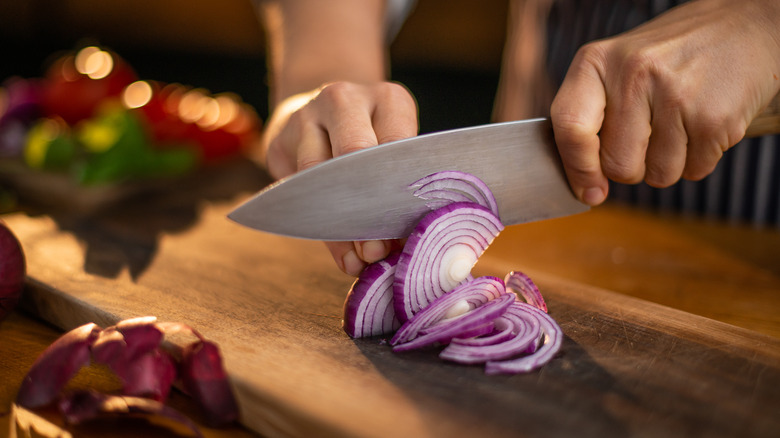You're Probably Holding Your Kitchen Knife Wrong. Here's How To Do It Right
Learning knife skills in the kitchen might seem intimidating, but it's well worth the effort. Watching a master chef like Jacques Pépin doing something as simple as peeling an apple becomes a mesmerizing show thanks to his enviable skills. These skills are also good for much more than just showing off in the kitchen, however — learning the proper knife skills can also help make cooking safer.
After all, you are wielding a sharp instrument next to your hands, so you want to be sure you're doing it correctly. There are a lot of different elements to consider when trying to improve your knife safety. Wielding a well-sharpened and honed blade might sound scary, but it can actually reduce the chances of cutting yourself. Using the right knife for the job is another important tenant of knife safety.
Before you rush off to learn all the fanciest knife cuts though, it's smart to start with the basics. In this case, that means making sure you have the correct knife grip.
The pinch grip
The first time you ever picked up a knife in the kitchen you likely used the most natural grip which is called the handle grip. That means you did the logical thing and wrapped all five fingers around the handle of the knife. There's nothing wrong with this grip, but it is not the most efficient, or safest, way to grip your blade.
The proper method is called the pinch grip. While your bottom three fingers (pinky, ring, and middle) stay on the handle, your hand chokes up more on the blade, and you pinch it lightly between your thumb and pointer finger. This is the grip used most by professional chefs because it is a more efficient way to cut with a knife. Gripping higher up on your knife allows you to use the weight and sharpness of the blade to make your cuts. It's also safer as well because it's going to give you more control to make precise cuts.
This grip might be more uncomfortable if you're using a bolstered knife. A bolster is a piece of metal added where the blade meets the handle. It's meant to add more weight to the back end of the knife but makes it harder to have a secure pinch grip.
What to do with your off-hand
While having a good grip on your knife is important, it's also smart to keep your other hand out of harm's way. Your opposite hand is the one that you'll need to hold your food in place, and it's just as important to use a safe grip on your food.
The safest grip for your off-hand is called "the claw"'. It involves curling your fingers up into a claw so that the first knuckle is positioned under the rest of your fingers. You then press that bottom knuckle down onto the food, and press your thumb into the side to hold the food in place. You'll need to continue moving your hand down the food as you cut, but this should give a steady and safe grip.
With this grip, you'll have your fingers tucked away safely instead of spread out along the knife's path. If you do happen to miss a cut, it should bump against your vertical knuckle without causing any harm.


